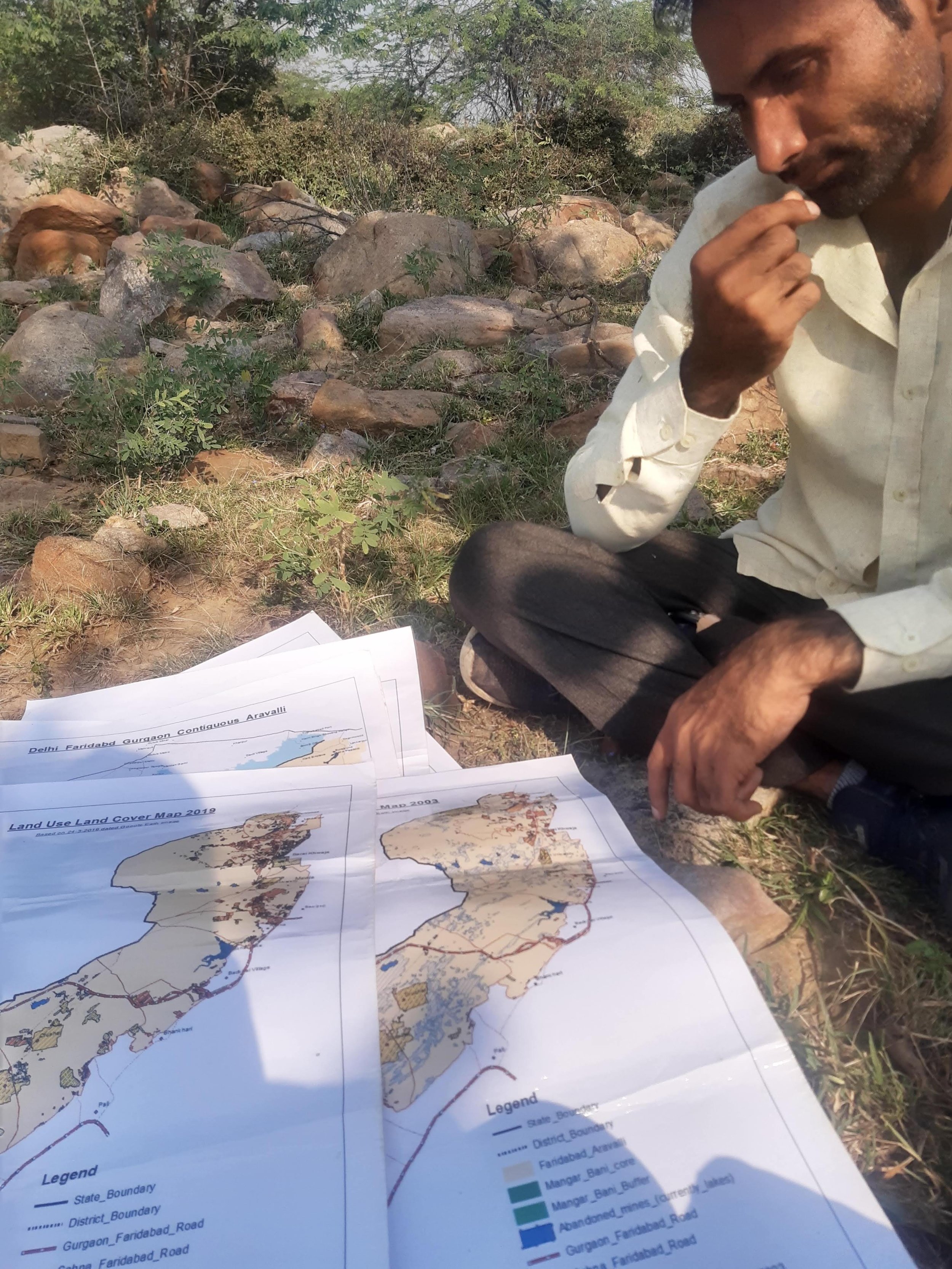One of the wonderful opportunities we have at TfW is our collaboration with Sanctuary Asia on their Mud on Boots project. We speak to grantees to explain TfW’s mission, and if our work can build on their projects in any way, we find ways to collaborate. We have connected with amazing practitioners through this program - one such grantee is Sunil Harsana. While on a visit to Delhi for work, we were able to visit his field site and meet him in person in November 2021 so we could better understand his work.
I was eager to see the sacred grove in Mangar Bani. It’s not often that I get to visit new places close to where I grew up. Even so, I didn’t expect to be as surprised as I was. While I had been to Mangar before, I hadn’t visited the sacred grove, which was just 40 minutes from my house. The taxi driver and I were both in for a surprise. Neither of us could believe where we ended up this short drive later.
Sunil Harsana in Mangar Bani.
The next few hours were a beautiful lesson on Mangar Bani, as Sunil unravelled the landscape with as much ease as the maps he was carrying. We stood staring at the rolling Aravallis in every direction, and I couldn’t believe the scale of what I was seeing. As we walked along, I heard Sunil’s descriptions of the species we saw, and of how unique and precious the ecosystem was. He went on to explain the cultural significance of the grove, the historical temples in juxtaposition to the current land pressures in the area. The scientific, cultural and political contexts were laid out for me to better understand the land with which I was being acquainted.
Layered in this narrative was Sunil’s own story. Of how his life is deeply rooted here, from his ancestry and childhood to his future. His family, his work, his aspirations - everything is intertwined with Mangar Bani, much like the root systems of the Dhok trees that it supports. The majority of this dry, deciduous forest is made up of Dhok (Anogeissus pendula) trees. Dhok is a slow-growing tree taking up to 10 years to reach a height of 5ft. It begins its life cycle by clinging to the rocky slope, acting as a substrate for groundwater recharge. This craggy hillside of Haryana Aravallis is covered with Dhok in various stages of its life cycle, from grass-like substrate form to very tall trees. The tree with its tiny leaves and crooked trunk yields extremely hard timber that is used for making tool handles.
Sunlight filtering through the foliage.
In the face of immense land pressure and legal loopholes, Sunil is dedicated to the long-term protection of this vulnerable landscape. He is gathering data and evidence about the biodiversity of the area and increasing the appreciation for its ecological value amongst both urban and rural youth. The area is a High-Biodiversity Zone with over 30 native tree species and 100 native shrubs and herbs which provide shelter to the wildlife, rare birds and part of the Northern Aravalli leopard corridor. Mangar Bani and its surroundings also form a water catchment and groundwater recharge zone, while sequestering carbon and releasing oxygen to the National Capital Region (NCR). Sunil’s vision is to demonstrate the value of the ecosystem and secure legal protection for it in order to ensure its long term preservation.
Sunil with maps of the region.
Sunil is unwavering in his efforts to raise awareness about the sacred grove. He began campaigning for the protection of Mangar Bani over a decade ago, and founded the Mangar Eco Club in 2015. At the Eco Club, community youth work to increase awareness about Mangar Bani and its potential among local and urban children. The members spend the monsoon months planting seeds of native species in the degraded areas, from those collected in the grove in summer. They also go birdwatching, build check dams, participate in clearing the grove and litter, and document the biodiversity of the hills.
The discovery of Palaeolithic cave-paintings in May 2021 revived calls for the forest to be protected. Activists and environmentalists like Chetan Agarwal, who have studied the forests and flora of Mangar Bani extensively have demanded that the Government should designate it as a sanctuary or national park for permanent conservation.
Sunil has rare clarity about his vision of Mangar and his work. This made collaborating with him really straightforward. He knew the gaps in his work and we figured out what was possible for us to do to help him address these gaps. One of the challenges he was facing was with data collection - he wanted a way to document evidence of wildlife presence when they were conducting routine walks, even when formal wildlife surveys were not taking place. We worked with him to adapt his existing flora and fauna surveys into Open Data Kit (ODK) surveys. This should also make data entry and storage more efficient. Additional information about this can be found in a previous blogpost by my colleague.
Dhok trees thriving in the Haryana Aravallis.
It was satisfying to play a small part in Sunil’s vision for Mangar. It was a privilege to get a peek into his world, and receive a glass of fresh chhach (buttermilk) from his mother. We intend to continue visiting and collaborating to build a future where I hope the Aravallis are replete with Dhok, owls, children and leopards.
Sunil is part of the Coexistence Fellows 2022- Cohort, working with Nitesh Kaushik on understanding leopard ecology and enhancing human-leopard coexistence in the Aravallis of south Haryana.




